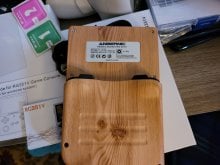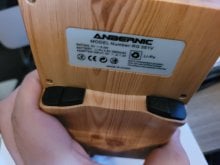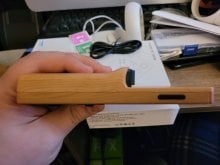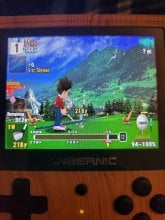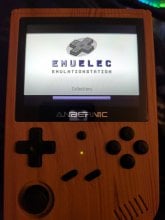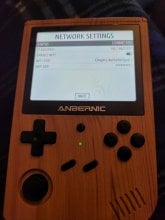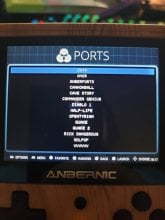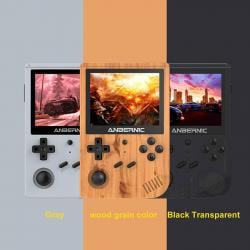 Anbernic RG351V (Hardware)
Anbernic RG351V (Hardware)
Official GBAtemp Review
Product Information:
Wood Grain is Sexy
Anbernic has been making retro game handhelds for a few years now, with various form factors and hardware configurations available, mostly being ARM and MIPS based. The RG351V is their latest entry into the RG350 series, a portrait, Gameboy-esque form factor that has basically the same internal hardware as their previously released RG351M. Promising support for everything from NES up to Dreamcast and PSP, does it actually deliver? Let’s find out.
Specifications:
- CPU: Rockchip RK3326, 4x Cores @ 1.5GHz
- GPU: Mali-G31 MP2
- RAM: 1GB DDR3L
- Screen: 3.5” IPS display, 640x480 resolution
- Sound: Single Mono speaker, 3.5mm headphone jack
- Battery: 3900mAh
- Storage: 2x TF card slots, supporting a maximum of 256GB each
- OS: EmuELEC 3.8
As usual, first we’ll take a look at what you’ll get if you buy your own RG351V. Contents of the box are fairly simple, you’ll get the device itself (available in three different color variants: Gray, Transparent Black, and Wood Grain), a screen protector along with cleaning cloths to apply it, a USB-C cable, and a couple of instructions manuals. All in all, pretty standard stuff, though the screen protector is appreciated. My particular unit was the Wood Grain variant, and...just look at this thing! It is beautiful. The device in general feels really good in the hand, the case itself feels really solid and well built and is comfortable enough to hold for long periods of gaming. In terms of controls, you get the standard ABYX Start+Select, an analog stick, a D-pad, a function button (which allows you to do various things like access the Retroarch menu, load/save states, or quickly change the volume), and L1/L2 R1/R2 buttons on the back. A second analog stick would’ve been a nice to have, but is understandably missing given the size and design of the handheld. You’ll find a volume rocker on the left side of the device, and a power and reset button on the right hand size. The buttons feel fairly good to press, they’re not mushy and have a nice satisfying click all around. You also get a single vibration motor, which is a nice addition to these kinds of handhelds.
Hardware-wise, the RG351V is...disappointing, to say the least. The particular chipset in use is the same used in some of their previous handhelds, including the RG351P and RG351M, and because of its age you’re going to really struggle with titles on the latter end of their list of “supported consoles” that they advertise (but we’ll get into that next). In terms of connectivity, the RG351V has two USB-C ports, with one functioning as charge/OTG, and the second being OTG only which is...an interesting, but IMO ultimately unnecessary design. You’ll also get two micro SD card slots, with each officially supporting up to 256GB MSD cards that will give you more than enough space for all of your games. Mine came with both a 16GB and 64GB card included, which were loaded with ROMs, but your mileage may vary. The RG351V also includes wifi support, allowing you to transfer games over via SFTP if you wanted as well as including support for things like wireless multiplayer as well as Retroarch’s built-in RetroAchievements, which is a nice touch. The 3.5” IPS display also looks quite good, with excellent brightness and colors, and there's no noticeable input lag that I can see during my quick tests.
Battery life, on the other hand, is a little...weird, and tough to really tell at times. The RG351V includes a 3900mah battery, which is pretty decent for devices like this, and Anbernic promises up to about 6 hours of battery life, give or take depending on what you’re playing. I measured about 4.5 hours myself, running a variety of SNES, GBA, and some N64 games throughout that time at 50% brightness, which is all well and good. The problem, however, is with the battery indicator they’re using in EmuELEC: it sucks. I’m not quite sure how they happen to measure it, but however they do it is flawed at best. In some cases, the battery indicator was telling me I had “0% battery left”...and then would run for about 2 hours no problem. Other times, the battery would go from 100% to 30% after a couple hours, and then a little while later jump back up to 45% when swapping games. During my battery life tests, after about 2 hours the battery dropped from 100% to 35%, and then went on for another 2.5 hours while playing some N64 games (which would stress the battery the most, I’d expect). Clearly something in their calculations are off, which makes it difficult to really gauge when you should start stopping and saving your game. It’s not the worst problem in the world, but you should definitely keep an eye on the time if you plan on extended play sessions to avoid loss of progress just in case.
But let's get into the meat of the device and, presumably, why someone would buy one: the software. Because the RG351V is running EmuELEC, and thus Retroarch (1.8.9, to be exact), the quality of emulation is going to be about as good as you could expect from any other device running Retroarch. Everything from the NES->PS1 era will run basically flawlessly on the RG351V, even with their relatively old RK3326 SoC, which is good, and you can even get away with enabling a few shaders as well to make games look a tad bit better if you’re into that kind of thing. Most older arcade titles will also run fairly well, so long as you curb your expectations for latter titles. But what caught my eye the most when checking out Anbernic’s official list of supported consoles were the following: NDS, DC, N64 and PSP. Surely a handheld with these kinds of specs can’t handle emulating any of these consoles, right? Well...yeah, actually, that’s right for the most part. Despite claiming official support for these systems on their website, in actuality it’s a bit more complicated than that. PSP emulation, for example, just isn’t there. You could probably get away with those few easy to emulate 2D titles like FF4 or Corpse Party and the like, but TBH don’t even bother trying anything 3D because it just will not run smoothly. My particular device included a few games on it preinstalled, like Hot Shots Golf Open Tee, and that game ran at a buttery smooth...15fps, with lots and lots of frameskip. Ouch. The same can be said for NDS, where any of the Pokemon games, Mario Kart DS, and even Super Mario 64 DS ran at basically 15-25fps max, with frameskip enabled. Gross.
Dreamcast and N64 are on the better end of the spectrum, but face their own unique problems. For Dreamcast, every game I’ve tested had some pretty gnarly frame drops here or there, including things like Crazy Taxi, Sonic Adventure 1 and 2, and Skies of Arcadia, but with some additional fiddling in the settings you could make those drops at least tolerable for some games. For N64, you’ll actually find a decent number of games that run well...but only with the Rice video plugin, which means you’ll have to deal with the grosser graphical glitches in a fair number of games. There’s also the lack of buttons as well which can be tough to get around, although Anbernic has a solution for this with R2+ABXY acting as the C buttons. You could probably get around this by having separate mappings for the C buttons on the D-pad/analog stick, since most games don’t use both at the same time, but I personally find that a little tedious so just deal with their button combos. You can certainly get away with playing games like Mario Kart 64 or Super Mario 64 no problem, but I’d probably stay away from things like Goldeneye 64, OoT/MM, or the Banjo games based on performance/control issues.
But you're not just limited to Anbernic's EmuELEC Distro, if you really don't want to be. There are some community-supported OS's that have beta support for the RG351V, including ArkOS, 351Elec, and TheRA, all of which have their own little benefits and quirks. I did test a couple, mainly ArkOS and 351Elec. Installing these are quite simple, and if you've used a Raspberry Pi device at any point you'll be fairly familiar with the process. Simply download the supported OS from their various Github repos/download links, flash the .img files to an SD card, and place it in the TF1 slot on the RG351V. Once done, the OS will expand the filesystem and move some files, and then you'll be booted right into EmulationStation just like the default OS. Overall, the only main benefit I've found for these community-supported OS's (beyond the usual benefits of community-supported OS's being supported much longer than a stock OS) is the ability to use AnberPorts, a third party application that allows you to download and setup various open-source ports that are being ported to the RG350 series of handhelds...but that doesn't happen to work on the default OS installed on the RG350 series handhelds for some reason. The current list of supported games is fairly impressive, with the usual Doom, Quake, Duke3D, and Wolfenstein ports that you'd expect on basically every device these days, but also includes ports of things like System Shock, Diablo 1 and Diablo 2 (although 2 is currently in beta, and not totally stable yet), AM2R, and even a port of Undertale is available if you're still playing that for whatever reason. Some of these games don't quite translate as well into a handheld format as you expect (Diablo 1 and 2 specifically being...very rough to play), but it's still an interesting project you should look at, if you're interested in things other than emulation. But game ports aren't the only thing AnberPorts offers, you'll also find downloads for popular game streaming services as well! GeForce Now, Stadia, Amazon Luna, and Moonlight are also all available to download and use on your RG351V if you so desire...but I wouldn't bother wasting the bandwidth on them, since you're limited to the integrated 2.4GHz Wifi chip included in the RG351V which is...slow to say the least.
So is the RG351V worth getting? I suppose that’s going to depend on you. If you want to have a separate handheld for retro games that’s very portable, looks good and is well put together, I would consider the RG351V as one of the more viable options.
Verdict
- Great build quality.
- Running EmuELEC and Retroarch, so good emulation.
- Has OpenSource, community-supported OS's.
- Good screen.
- There's a sexy Wood Grain one <3
- Battery life indicator is a bit wonky.
- Doesn't quite live up to their claims of NDS/DC/N64/PSP support.
- Hardware is pretty meh.


